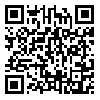Volume 81, Issue 10 (January 2024)
Tehran Univ Med J 2024, 81(10): 760-770 |
Back to browse issues page
Download citation:
BibTeX | RIS | EndNote | Medlars | ProCite | Reference Manager | RefWorks
Send citation to:



BibTeX | RIS | EndNote | Medlars | ProCite | Reference Manager | RefWorks
Send citation to:
Javanmard A, Salehan A. Seasonal impact analysis on COVID-19 severity: insights from homogeneous epidemiological hospital data using the jaccard correlation coefficient. Tehran Univ Med J 2024; 81 (10) :760-770
URL: http://tumj.tums.ac.ir/article-1-12841-en.html
URL: http://tumj.tums.ac.ir/article-1-12841-en.html
1- Department of Computer Engineering, University of Imam Reza, Mashhad, Iran.
2- Department of Computer Enginnering, University of Torbat Heydarieh, Heydarieh, Iran.
2- Department of Computer Enginnering, University of Torbat Heydarieh, Heydarieh, Iran.
Abstract: (687 Views)
Background: Coronaviruses were discovered in 1960. Large-sized living organisms from the Coronaviridae family, with single-stranded RNA of animal origin. Coronaviruses in humans can cause mild respiratory illness or severe respiratory illness. In 2020, the World Health Organization declared COVID-19 a global pandemic. The aim of this study is to use the Jaccard similarity coefficient to determine the similarity of COVID-19 behavior patterns in different seasons of the year.
|
Methods: This study used machine learning systems and similarity metrics to determine the behavior pattern of COVID-19 in different seasons of the year. The location of research was the Mousa ibn Ja'far Hospital in Mashhad, and the time was from May 2020 to August 2021. The symptoms of affected patients were compared with the compiled dataset, and the similarity of patients was prepared in a similarity matrix, and the Jaccard correlation coefficient was calculated on the data. Finally, the analysis of strains from the beginning of emergence to the latest strain was examined. The performance indicators of the algorithm in the Jaccard similarity method showed a recall metric with a value of 0.94, a precision metric with a value of 1, an F1 score with a value of 0.86, and remove accuracy metric with a value of 0.76. The most important factors in the investigation include white blood cells, platelets, RT-PCR, CT SCAN, shortness of breath, fever, SPO2, and respiratory rate.
Results: The transmission of the COVID-19 virus depends on several factors, including human interaction. The evidence of the collected data shows that people with COVID-19 have low lymphocyte count and it is very consistent with the results of recent studies. Due to the lack of a dataset, a comparative study was conducted and a dataset was collected. Conclusion: This study, leveraging machine learning algorithms, identified a clear seasonal correlation in the spread of COVID-19. Considering geographical and seasonal variations among patients, distinct symptoms were observed in each season corresponding to the prevalent strain during that period. |
Type of Study: Original Article |
| Rights and permissions | |
 |
This work is licensed under a Creative Commons Attribution-NonCommercial 4.0 International License. |





